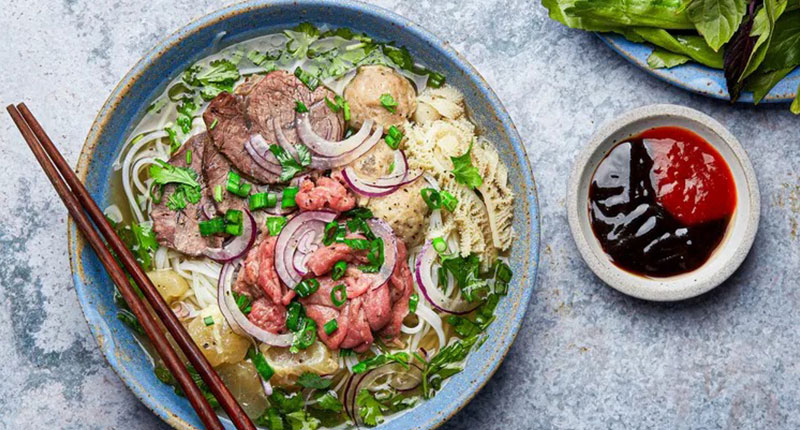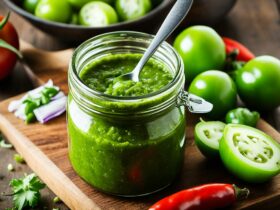Pho, a traditional Vietnamese soup, is a beloved dish that offers a burst of flavors and comforting warmth. With its aromatic broth, tender meat or tofu, and an array of fresh herbs and spices, pho has gained popularity worldwide. While you can find pho in many Vietnamese restaurants, making it at home allows you to customize the flavors and enjoy a bowl of this delicious soup anytime you desire. In this article, we will guide you through an easy homemade pho recipe that will bring the authentic taste of Vietnam to your kitchen.
Pho is a traditional Vietnamese soup that combines rice noodles, flavorful broth, and various toppings. It is a staple dish in Vietnam and has gained immense popularity around the world. The rich and aromatic flavors of pho are derived from a delicate balance of herbs, spices, and slow-cooked ingredients. Making pho at home allows you to experiment with different flavors and create a bowl tailored to your taste preferences.
Ingredients
To make a delicious homemade pho, you will need the following ingredients:
- Beef bones or chicken bones for the broth
- Onion, ginger, and garlic
- Cinnamon sticks, star anise, cloves, and cardamom pods
- Fish sauce and rock sugar
- Rice noodles
- Protein of your choice (beef, chicken, shrimp, tofu)
- Bean sprouts, Thai basil, cilantro, and lime for garnishing
- Hoisin sauce and Sriracha (optional)
Broth Preparation
The broth is the heart of a pho recipe. It's what gives the soup its signature flavor and aroma. Here's how you can prepare the broth:
- Begin by charring the onion and ginger. You can do this by placing them directly over a gas stove or under the broiler until they are slightly blackened.
- In a large pot, add the beef bones or chicken bones and cover them with water. Bring the water to a boil, then reduce the heat to low and simmer for at least 4-6 hours.
- Skim off any impurities that rise to the surface of the broth.
- Add the charred onion, ginger, garlic, cinnamon sticks, star anise, cloves, and cardamom pods to the pot.
- Simmer the broth for an additional 1-2 hours to allow the flavors to infuse.
- Season the broth with fish sauce and rock sugar to taste.
Preparing the Protein
While the broth is simmering, you can prepare the protein that will go into your pho. You have various options, including beef, chicken, shrimp, or tofu. Here's a simple method to prepare the protein:
- For beef or chicken, slice the meat into thin strips. Marinate it with soy sauce, garlic, and a dash of sugar for added flavor. Stir-fry the meat until cooked and set it aside.
- For shrimp, peel and devein them. Cook them in a separate pot of boiling water until they turn pink and opaque. Remove them from the pot and set them aside.
- For tofu, slice it into small cubes or strips. Pan-fry the tofu until it turns golden brown.
Recommend : Delicious Ankimo Recipe: A Japanese Delicacy
Assembling the Pho Bowl
Now that you have prepared the broth and protein, it's time to assemble your pho bowl. Follow these steps:
- Cook the rice noodles according to the package instructions. Drain and rinse them with cold water to prevent them from sticking together.
- Place a portion of cooked rice noodles into a serving bowl.
- Arrange the cooked protein on top of the noodles.
- Ladle the hot broth into the bowl, ensuring that the noodles and protein are fully submerged.
- The hot broth will cook the raw protein and warm up the noodles.
- Let the flavors meld together for a few minutes.
Serving and Garnishing
To enhance the flavors of your homemade pho, garnish it with a variety of fresh herbs and condiments. Here are some popular options:
- Bean sprouts: These provide a refreshing crunch to the soup.
- Thai basil: Its aromatic flavor complements the broth perfectly.
- Cilantro: Adds a vibrant touch and freshness to the dish.
- Lime wedges: Squeeze the lime juice into the soup to brighten the flavors.
- Hoisin sauce and Sriracha: Add these condiments according to your taste preferences for a touch of sweetness and spiciness.
Tips for Customizing Your Pho
While the traditional pho recipe is delightful on its own, you can personalize it to suit your preferences. Here are some tips for customizing your pho:
- Experiment with different types of protein, such as beef brisket, meatballs, or even seafood combinations.
- Add vegetables like sliced onions, mushrooms, or bok choy for extra texture and flavor.
- Adjust the level of spiciness by adding more Sriracha or chili oil.
- Explore different herbs and garnishes like mint leaves or sliced jalapeños for a unique twist.
Health Benefits of Pho
Pho is not only a delicious and comforting soup but also offers several health benefits. Some notable benefits include:
- Rich in nutrients: Pho is packed with vitamins, minerals, and antioxidants from the fresh herbs, vegetables, and bone broth.
- Hydration: The broth-based nature of pho helps keep you hydrated.
- Supports digestion: The herbs and spices in pho can aid digestion and provide relief from common digestive issues.
- Protein source: Pho with meat or tofu provides a good source of lean protein.
Conclusion
Creating your own homemade pho allows you to savor the authentic flavors of Vietnamese cuisine in the comfort of your home. With a few simple ingredients and some patience, you can enjoy a bowl of flavorful and aromatic pho soup. Customize it with your favorite protein, herbs, and condiments to create a truly personalized culinary experience. So, gather the ingredients, follow the steps, and indulge in the delightful taste of homemade pho.
FAQs (Frequently Asked Questions)
Q1: Is pho gluten-free?
- Pho can be gluten-free if you use rice noodles and gluten-free soy sauce. However, it's essential to check the ingredients of the broth and condiments for any potential gluten sources.
Q2: Can I make vegetarian or vegan pho?
- Yes, you can make vegetarian or vegan pho by using vegetable broth and tofu or mushrooms as the protein. Substitute fish sauce with soy sauce or tamari for a vegetarian version.
Q3: How do I store leftover pho?
- Store the broth, noodles, and protein separately in airtight containers in the refrigerator. When reheating, bring the broth to a boil and assemble the pho bowl with fresh garnishes.
Q4: Can I freeze pho?
- Yes, you can freeze pho. Freeze the broth separately and thaw it when you're ready to enjoy a bowl of pho. Cook fresh noodles and protein to assemble the pho.
Q5: Can I add more herbs and spices to my pho?
- Absolutely! Feel free to experiment with additional herbs and spices in your pho to enhance the flavors according to your taste preferences.














